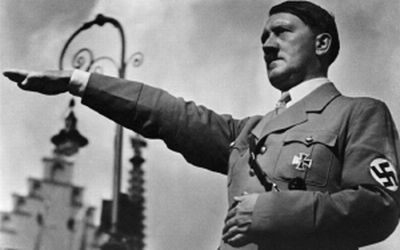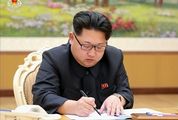BERLIN — Not since 1945, when the Allies banned the dubious work and awarded the rights to the state of Bavaria, has Hitler’s manifesto, Mein Kampf, been officially published in German.
Bavaria had refused to release it. But under German law, its copyright expires December 31, the 70th year after the author’s death.
That allows a team of historians from a noted centre for the study of Nazism, the Institute for Contemporary History in Munich, to publish its new two-volume, 2,000-page edition, a three-year labour complete with about 3,500 academic annotations.
The intention is to set the work in historical context, to show how Hitler wove truth with half-truth and outright lie, and thus to defang any propagandistic effect while revealing Nazism.
"This is really one of the best relics we have of the Third Reich," said Christian Hartmann, the historian who led the five-person team on the project and unveiled the work to journalists on Tuesday. He compared it with Hitler’s lair at Obersalzberg in the Alps, which 2-million visitors a year now view, passing first through an exhibit on Nazism designed by the institute.
Germans have become more at ease with public mention of Hitler, even reintroducing him in popular culture, as in the 2004 movie Downfall and a newly filmed version of the best-selling comic novel Look Who’s Back.
The new edition of Hitler’s two-volume work — a combination of memoir, party programme, anti-Semitic rant and exposé on how to gain power — certainly would not be a conventional publishing sensation.
Mr Hartmann and the institute’s director, Andreas Wirsching, said it was not clear whether the first run of about 3,500-4,000 copies would sell, either modestly or extraordinarily well, when it appeared in January.
Mein Kampf, whose two volumes appeared first in 1925 and 1927, was started while Hitler was jailed for trying to gain power in a putsch in November 1923. Accordingly, it was a hodgepodge of personal memory and justification of failure, a collation of maudlin nationalism and serious literature, woven into a tract that shows in part how Hitler forged his National Socialist creed and, over time, the first popular mass party of 20th-century Germany, the two men said.
The book has a special layout, with Hitler’s original text on the upper right page of a two-page spread, coupled with small notes on grammatical and other variations among editions published during Hitler’s lifetime and, on the left-hand page, larger comments giving context.
The result is systematic and dense, and requires close attention. "We wanted literally to surround Hitler with our comments," Mr Hartmann said.
The two-volume edition would sell for €59 with more than 200 orders to date, Mr Wirsching and Mr Hartmann said. There would be no special school edition, although "every intelligent history teacher can work with our comments", Mr Hartmann said. He said that there would be no e-book, but that discussions to make the work available online were continuing.
Mr Hartmann noted that he had worked on an earlier volume of Hitler’s speeches from the mid-1920s into the 1930s. "The public interest was almost zero," he noted with a smile.
Sven-Felix Kellerhoff, a historian and senior editor at the daily Die Welt, argued that Mein Kampf elicited a special fascination mostly because of the ban imposed in 1945 by the Allies and extended ever since by Bavaria.
"The problem with Mein Kampf is that everyone knows the title but nothing of the book itself," Mr Kellerhoff said in an interview. "The myth is that it is banned, and so dangerous that the German public cannot be trusted with it.
"The false policy of Bavaria gave rise to this myth," he added, arguing that Bavaria should have lifted the ban at the very latest by the 1980s or 1990s, when a generation had grown up without Nazism.
Mr Kellerhoff has just published his own book, Mein Kampf: The Career of a German Book, which runs a little less than 370 pages and traces the history of Hitler’s work.
Mein Kampf is available online, and printed copies can be obtained at antique shops or markets, particularly in countries bordering Germany. During Nazi rule, from 1933-1945, it was translated into 18 languages and sold more than 12-million copies.
Mr Wirsching and Mr Hartmann said the project had been discussed at length with several interlocutors abroad, particularly at Yad Vashem, the Holocaust memorial in Israel. Most of them have approved of the idea, which both depicted at least in part as honouring Hitler’s victims.
Charlotte Knobloch, who grew up in Munich, witnessed the 1938 killing and persecution of Jews and destruction of Jewish synagogues and businesses there. She is now a Jewish leader in the city, the Bavarian capital.
A spokesman who answered the telephone on Tuesday referred to a statement he said she had permitted him to issue. It characterised Mein Kampf as a "disgusting incitement to hatred and the basis of the Holocaust". Thus, it added, the original text deserved neither discussion nor acknowledgment today.
NYTimes.com

Picture: SUPPLIED
Photograph by: Picture: SUPPLIED
BERLIN — Not since 1945, when the Allies banned the dubious work and awarded the rights to the state of Bavaria, has Hitler’s manifesto, Mein Kampf, been officially published in German.
Bavaria had refused to release it. But under German law, its copyright expires December 31, the 70th year after the author’s death.
That allows a team of historians from a noted centre for the study of Nazism, the Institute for Contemporary History in Munich, to publish its new two-volume, 2,000-page edition, a three-year labour complete with about 3,500 academic annotations.
The intention is to set the work in historical context, to show how Hitler wove truth with half-truth and outright lie, and thus to defang any propagandistic effect while revealing Nazism.
"This is really one of the best relics we have of the Third Reich," said Christian Hartmann, the historian who led the five-person team on the project and unveiled the work to journalists on Tuesday. He compared it with Hitler’s lair at Obersalzberg in the Alps, which 2-million visitors a year now view, passing first through an exhibit on Nazism designed by the institute.
Germans have become more at ease with public mention of Hitler, even reintroducing him in popular culture, as in the 2004 movie Downfall and a newly filmed version of the best-selling comic novel Look Who’s Back.
The new edition of Hitler’s two-volume work — a combination of memoir, party programme, anti-Semitic rant and exposé on how to gain power — certainly would not be a conventional publishing sensation.
Mr Hartmann and the institute’s director, Andreas Wirsching, said it was not clear whether the first run of about 3,500-4,000 copies would sell, either modestly or extraordinarily well, when it appeared in January.
Mein Kampf, whose two volumes appeared first in 1925 and 1927, was started while Hitler was jailed for trying to gain power in a putsch in November 1923. Accordingly, it was a hodgepodge of personal memory and justification of failure, a collation of maudlin nationalism and serious literature, woven into a tract that shows in part how Hitler forged his National Socialist creed and, over time, the first popular mass party of 20th-century Germany, the two men said.
The book has a special layout, with Hitler’s original text on the upper right page of a two-page spread, coupled with small notes on grammatical and other variations among editions published during Hitler’s lifetime and, on the left-hand page, larger comments giving context.
The result is systematic and dense, and requires close attention. "We wanted literally to surround Hitler with our comments," Mr Hartmann said.
The two-volume edition would sell for €59 with more than 200 orders to date, Mr Wirsching and Mr Hartmann said. There would be no special school edition, although "every intelligent history teacher can work with our comments", Mr Hartmann said. He said that there would be no e-book, but that discussions to make the work available online were continuing.
Mr Hartmann noted that he had worked on an earlier volume of Hitler’s speeches from the mid-1920s into the 1930s. "The public interest was almost zero," he noted with a smile.
Sven-Felix Kellerhoff, a historian and senior editor at the daily Die Welt, argued that Mein Kampf elicited a special fascination mostly because of the ban imposed in 1945 by the Allies and extended ever since by Bavaria.
"The problem with Mein Kampf is that everyone knows the title but nothing of the book itself," Mr Kellerhoff said in an interview. "The myth is that it is banned, and so dangerous that the German public cannot be trusted with it.
"The false policy of Bavaria gave rise to this myth," he added, arguing that Bavaria should have lifted the ban at the very latest by the 1980s or 1990s, when a generation had grown up without Nazism.
Mr Kellerhoff has just published his own book, Mein Kampf: The Career of a German Book, which runs a little less than 370 pages and traces the history of Hitler’s work.
Mein Kampf is available online, and printed copies can be obtained at antique shops or markets, particularly in countries bordering Germany. During Nazi rule, from 1933-1945, it was translated into 18 languages and sold more than 12-million copies.
Mr Wirsching and Mr Hartmann said the project had been discussed at length with several interlocutors abroad, particularly at Yad Vashem, the Holocaust memorial in Israel. Most of them have approved of the idea, which both depicted at least in part as honouring Hitler’s victims.
Charlotte Knobloch, who grew up in Munich, witnessed the 1938 killing and persecution of Jews and destruction of Jewish synagogues and businesses there. She is now a Jewish leader in the city, the Bavarian capital.
A spokesman who answered the telephone on Tuesday referred to a statement he said she had permitted him to issue. It characterised Mein Kampf as a "disgusting incitement to hatred and the basis of the Holocaust". Thus, it added, the original text deserved neither discussion nor acknowledgment today.
NYTimes.com




















Change: -1.04%
Change: -1.17%
Change: -1.77%
Change: -0.53%
Change: -2.66%
Data supplied by Profile Data
Change: -1.04%
Change: -1.28%
Change: -1.04%
Change: 0.00%
Change: -1.32%
Data supplied by Profile Data
Change: 1.22%
Change: 0.99%
Change: 1.40%
Change: 1.76%
Change: -0.22%
Data supplied by Profile Data
Change: 1.54%
Change: -1.02%
Change: 0.43%
Change: -4.43%
Change: -6.09%
Data supplied by Profile Data